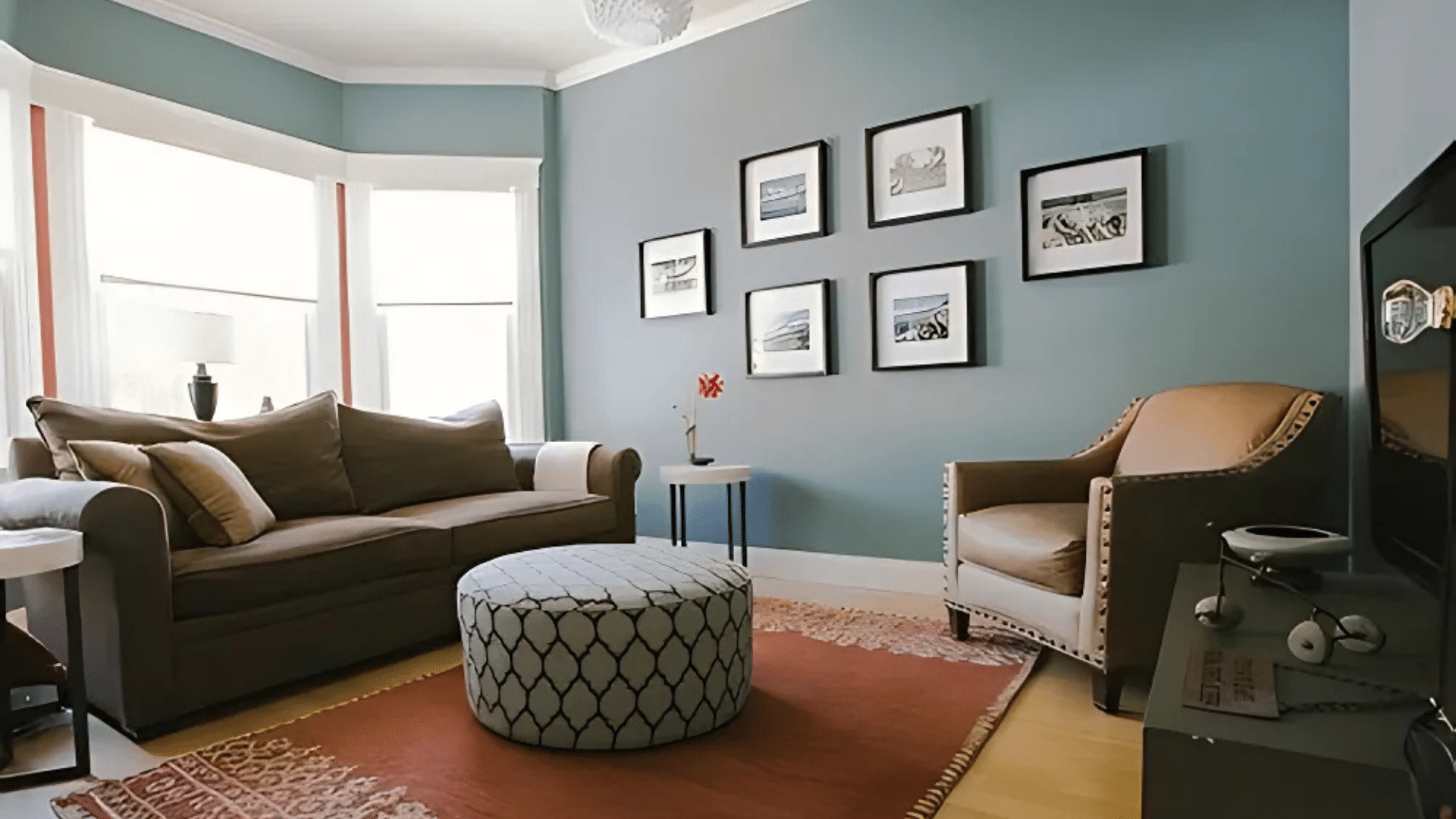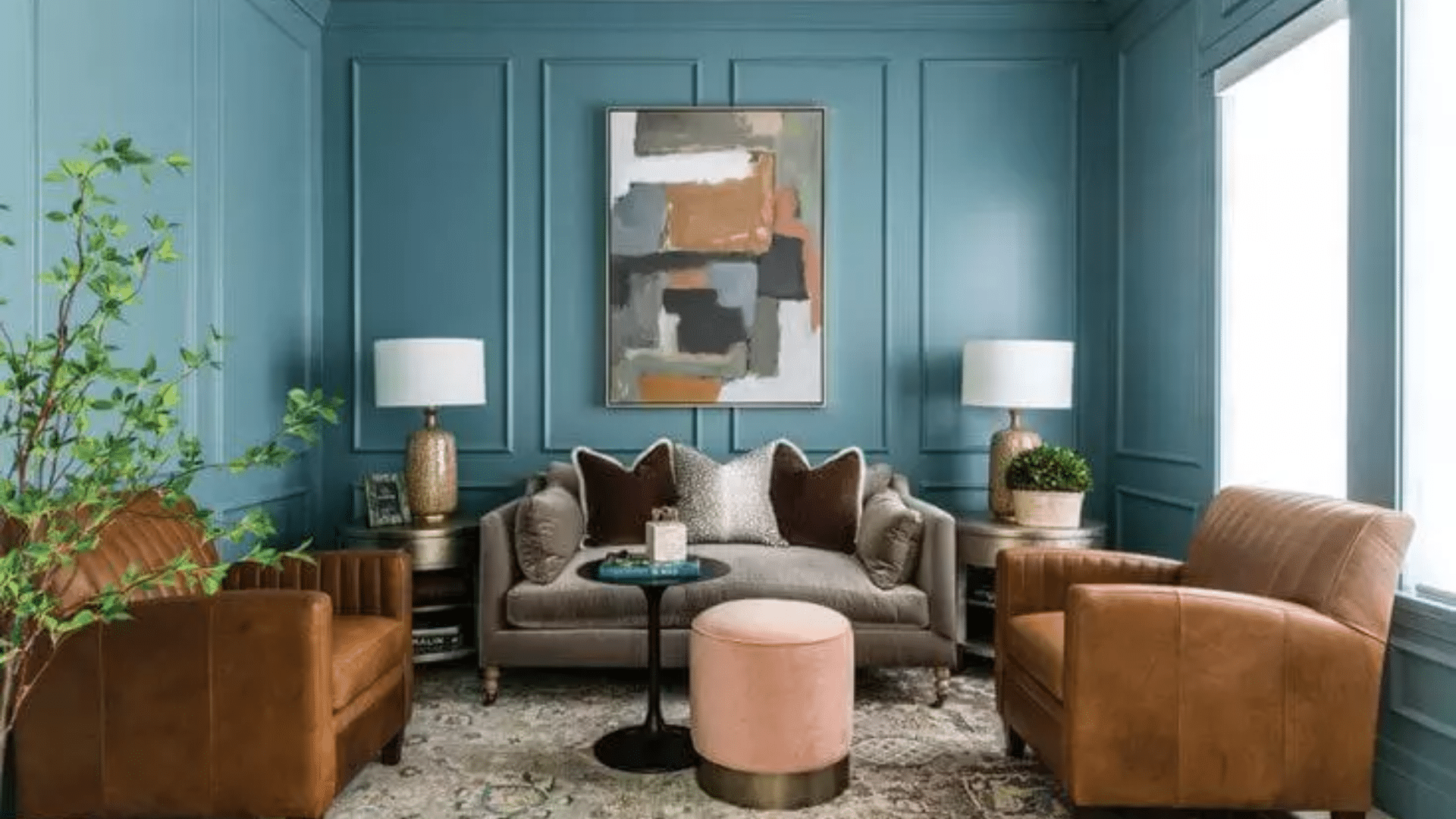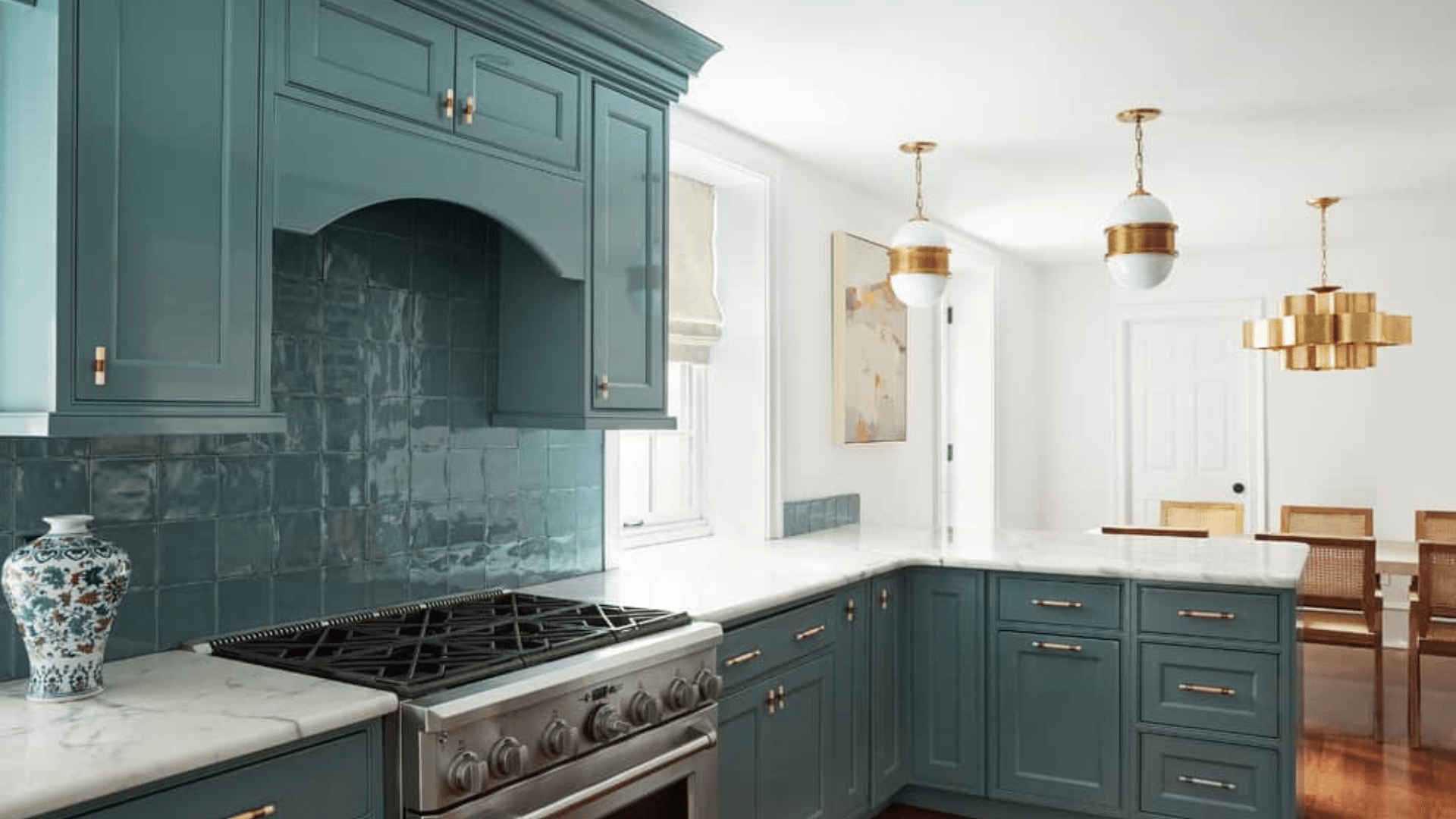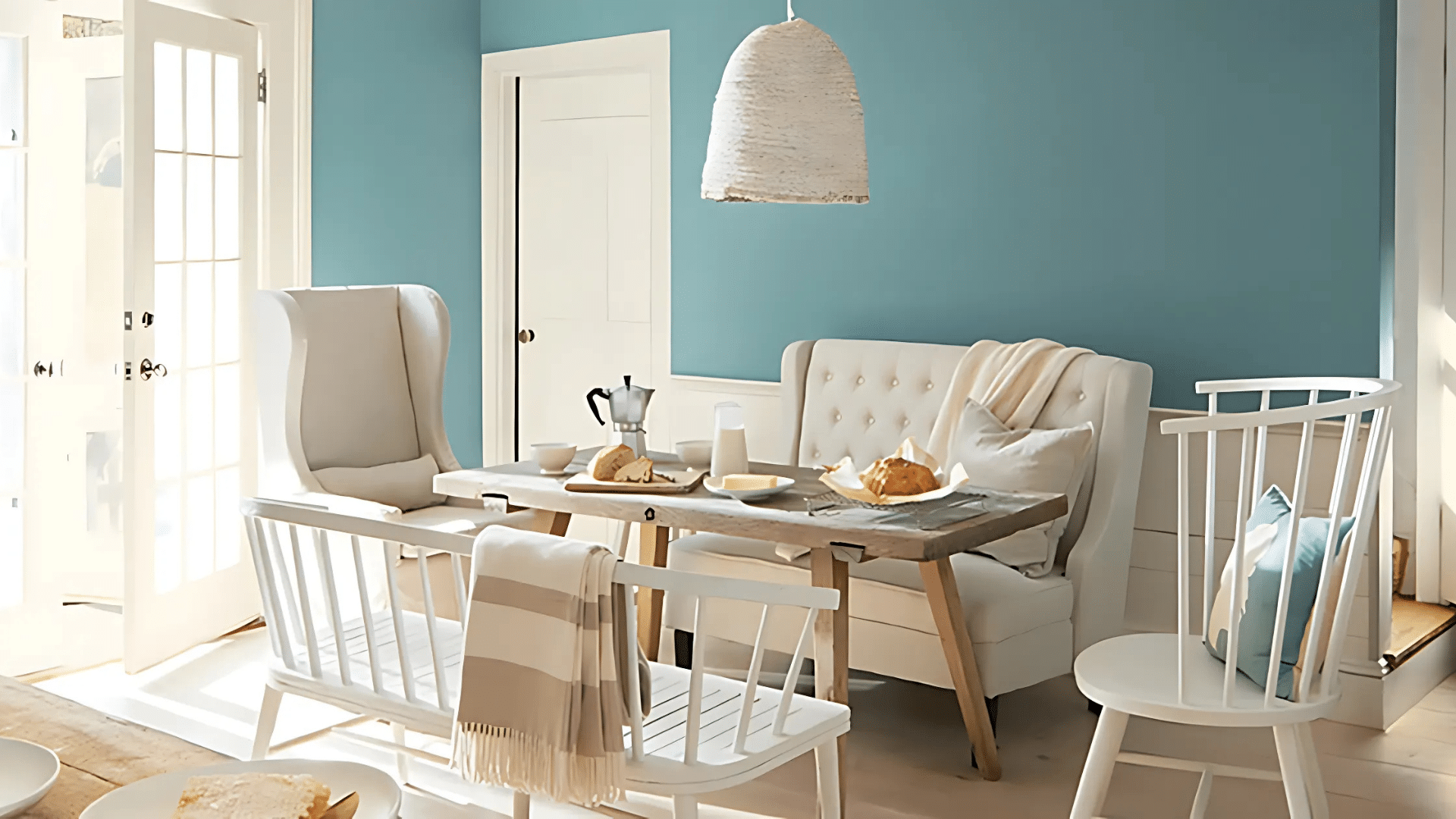Ever stood in front of paint swatches feeling completely lost? I’ve been there, too. That’s why I’m breaking down everything about Benjamin Moore’s popular Aegean Teal (2136-40) in this article.
You’ll discover what makes this blue-green-gray shade unique, see real homes using it, and learn exactly where it works best. I’ll help you decide if it’s right for your space without wasting money on the wrong color.
I’ve been painting homes for 15 years and have tested Aegean Teal in dozens of rooms. No sponsored content here—just honest observations about:
- How it looks in different lighting
- Which rooms it works best in
- Color combinations that enhance it
- Common mistakes to avoid
By the end, you’ll know if Aegean Teal is your perfect color match or if you should keep looking.
Why Aegean Teal (2136-40) Is the Perfect Choice for Your Space?

Aegean Teal is a soft color with enough depth to stand out. It works well when you want a peaceful look that still feels full and warm.
This is why it works so well in different rooms:
- The blue-green base adds calm without feeling too cold or too bright.
- It pairs well with wood, white, and metal finishes, making it easy to match.
- The color looks rich in natural light yet still smooth in darker spaces.
- It doesn’t overpower a room but still adds style and color.
- Great for both open spaces and cozy rooms, giving them a clean, settled look.
Aegean Teal helps create a soft, calm, and lived-in space. It’s a solid choice when you want a color that is easy on the eyes.
The Rich Undertones of Aegean Teal: What You Need to Know
Aegean Teal is a mix of green, blue, and gray tones that blend together to create a color that feels calm and full.
The green gives the color a warm and soft base. The blue adds a cool, steady feel. The gray helps balance everything, so the color doesn’t feel too bright or too flat.
Lighting plays a big role in how this shade looks. In natural light, the color may show more green or feel a bit lighter. In low or warm lighting, the gray stands out more, giving it a deeper look.
Because of these shifts, it’s smart to test this paint in your space before using it. Aegean Teal reacts to the room it’s in, which helps it feel natural and lived-in.
The LRV of Aegean Teal: What It Tells You
Aegean Teal by Benjamin Moore has an LRV of 25.13. LRV stands for Light Reflectance Value, which tells you how much light a paint color reflects. The scale goes from 0 (black) to 100 (white).
With a value around 24, Aegean Teal is on the darker side. It won’t brighten a room, but it also won’t make it feel closed in. It has just enough depth to add mood while still feeling soft.
In a room with lots of natural light, Aegean Teal may look lighter and more colorful. In dim spaces, it may feel deeper and more muted. That’s why it’s a good idea to test it on your wall before painting the whole room.
The LRV helps you know how the color will behave. Aegean Teal brings color and calm without making a room feel too dark or too plain.
The Psychology of Aegean Teal: How It Affects Your Mood

Colors can shape how a room feels, and Aegean Teal is a color that brings stillness. It’s soft, steady, and easy on the eyes.
This paint helps make a room feel peaceful. It can lower stress and bring a sense of calm, which is why many people use it in bedrooms, bathrooms, or spaces where they want to slow down.
It also supports focus and clear thinking, making it a good choice for work areas or study rooms. The balance of blue and green helps the mind feel calm but awake.
Aegean Teal also works well in shared spaces. Its quiet energy helps people feel at ease, making it suitable for kitchens, living rooms, or entryways.
Where Is Aegean Teal Best Used in An Interior?

This color fits in many types of rooms, from busy kitchens to quiet bedrooms. Its balance of color and calm makes it work well across the home.
Try Aegean Teal in spaces like:
- Kitchens: Aegean Teal works well on cabinets or walls, especially when there’s natural light. The color brings calm and color without being too much.
- Bedrooms: It helps create a soft, restful space, making it a great choice for walls where you want peace and quiet.
- Entryways or Hallways: Aegean Teal adds warmth to smaller spaces and gives guests a soft welcome as they enter your home.
- Living Rooms: When paired with light wood and simple fabrics, it gives the room a full look without feeling dark.
- Bathrooms: This shade brings in a clean, fresh feeling without being too sharp or cold.
Aegean Teal is steady and calm. It fits well in both bright and dim rooms, making it easy to use throughout the home.
What Kind of Floors Would Look Best with Aegean Teal?
The best flooring with Aegean Teal keeps the space balanced. Go with light or natural materials to support the soft, rich tone of the paint.
Good flooring choices include:
- Light Oak or Natural Wood: These bring warmth and contrast, helping Aegean Teal stand out without making the room feel too dark.
- Whitewashed or Soft Gray Floors: These create a fresh and open look. They work well in modern or coastal-style spaces.
- Matte Tile in Beige or Cream: This keeps the space feeling soft and clean. It’s a solid choice for kitchens, bathrooms, or entryways.
- Warm-toned rugs or Carpets: Colors like tan or soft brown add comfort while staying quiet in the background.
- Natural Stone: A calm, textured floor-like stone gives the room a smooth base and works well with the cool tones of Aegean Teal.
When paired with these floors, Aegean Teal feels steady and full. The space becomes easier to enjoy and easier to live in.
How to Incorporate Aegean Teal Into Your Home Decor?

Aegean Teal pairs well with clean and simple decor. Its soft tone works best when the rest of the room feels light and natural.
Use light wood or neutral furniture, such as white or beige. This helps balance the depth of the wall color and keeps the room open. Add soft fabrics in off-white, tan, or gray for pillows, curtains, or rugs. These tones blend in without taking focus from the walls.
Brass or bronze finishes work well for lights or handles. They add a soft shine without feeling too bold. You can also use plants or natural wood pieces to bring in a calm and steady feel. Aegean Teal looks its best when the space feels warm, light, and easy to enjoy.
Aegean Teal vs. Other Blue-Green Shades: A Comparison
Benjamin Moore has a few popular blue-green paints, and each one gives a different look. Aegean Teal is softer and easier to use, while shades like Caribbean Teal and Blue Spruce feel stronger or cooler.
| Paint Color | Tone | Undertone | Best Used In | Look and Feel |
|---|---|---|---|---|
| Aegean Teal 2136-40 | Soft blue-green | Green, blue, gray | Bedrooms, kitchens, living rooms | Calm, soft, balanced |
| Caribbean Teal 2123-20 | Deeper teal | Blue-green | Accent walls, modern spaces | Bold, rich, cool |
| Blue Spruce 1637 | Cool teal | Blue with gray | Offices, dens, dining rooms | Moody, deep, cool |
Aegean Teal is the most balanced of the group. It adds quiet color to a room without feeling strong or cold, making it easy to use in many parts of the home.
Conclusion
Is Aegean Teal worth the hype? In my opinion, absolutely—but only in the right spaces. I’ve seen this color transform boring rooms into peaceful retreats. But I’ve also watched it fall flat in the wrong lighting.
Remember these key points:
- It shines in north-facing rooms
- It needs natural light to show its full depth
- It works magic with wooden accents
- It’s not for small, dark spaces
You don’t need to be a design expert to use this color well. Just be honest about your room’s lighting and your home’s style. Still on the fence? Grab a sample pot first.
Paint a 2×2 square on different walls and watch how it changes throughout the day. Trust your gut. If you love how Aegean Teal makes you feel, that’s all that matters.

